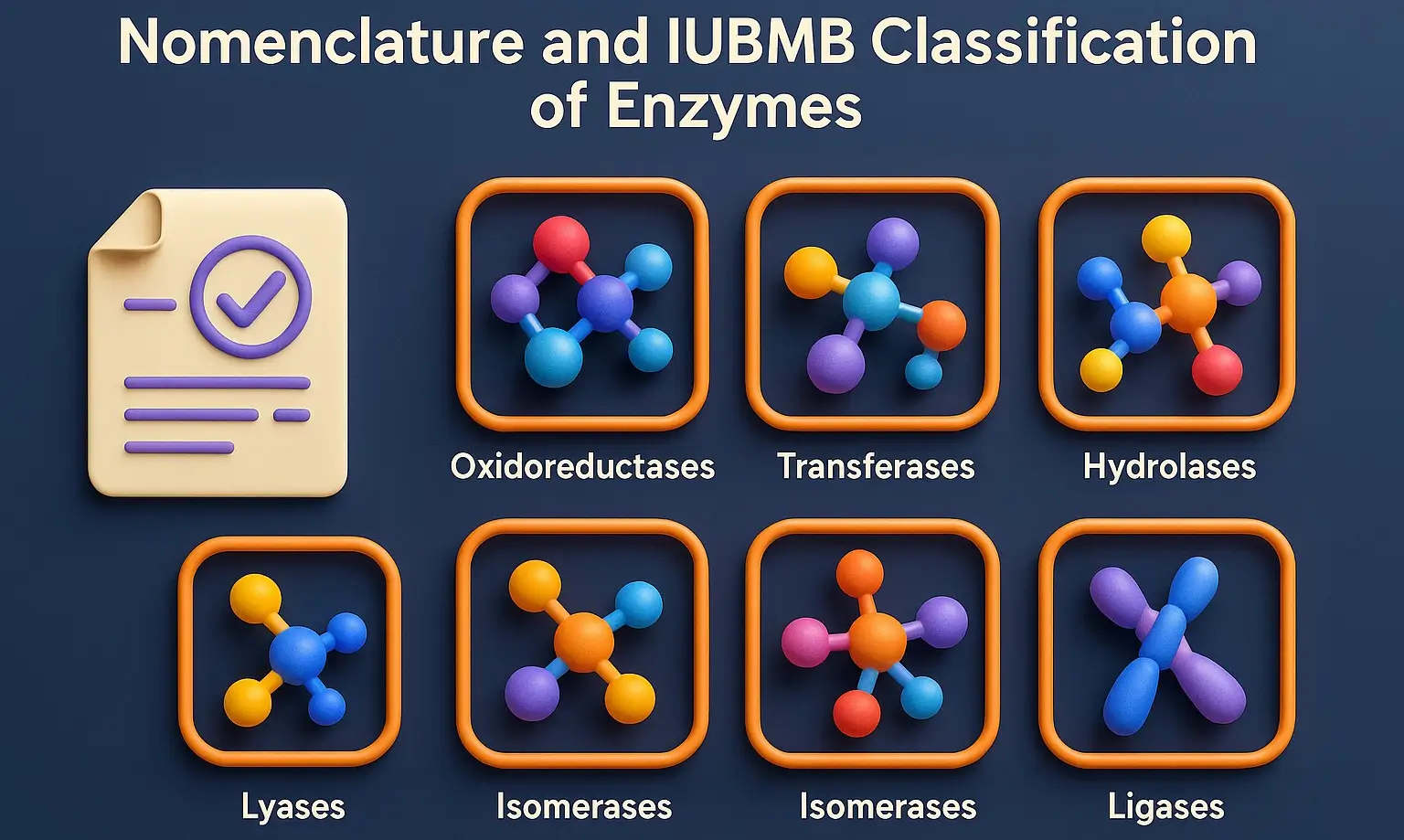- The nomenclature and IUBMB classification of enzymes refers to the systematic method used to name and categorize enzymes based on the chemical reactions they catalyze.
- nomenclature and IUBMB classification of enzymes system is governed by the International Union of Biochemistry and Molecular Biology (IUBMB).
Enzyme Nomenclature
-
Systematic and Descriptive Naming:
- Enzymes are named systematically to reflect the type of reaction they catalyze.
- Typically, the suffix “-ase” is added to the name of the substrate or the type of reaction.
-
Common Names:
- Some enzymes have common names that do not strictly follow the standard naming convention.
-
Examples:
- Sucrase: Enzyme that catalyzes the hydrolysis of sucrose.
- DNA Polymerase: Enzyme that catalyzes the polymerization of DNA strands.
IUBMB Classification
-
Enzyme Commission (EC) Numbers:
- Established by the International Union of Biochemistry and Molecular Biology (IUBMB).
- Provides a comprehensive and systematic classification of enzymes based on the reactions they catalyze.
-
Six Major Classes:
- Enzymes are divided into six main classes, each representing a broad type of reaction.
- Oxidoreductases
- Transferases
- Hydrolases
- Lyases
- Isomerases
- Ligases
- Enzymes are divided into six main classes, each representing a broad type of reaction.
-
EC Number Structure:
- Each enzyme is assigned a unique EC number consisting of four parts (e.g., EC 1.1.1.1):
- First Digit: Main class (type of reaction).
- Second Digit: Subclass (type of substrate or group transferred).
- Third Digit: Sub-subclass (specifics of the reaction).
- Fourth Digit: Serial number of the enzyme in its sub-subclass.
- Each enzyme is assigned a unique EC number consisting of four parts (e.g., EC 1.1.1.1):
The Six Major Classes of Enzymes
-
Oxidoreductases (EC 1)
- Catalyze oxidation-reduction reactions, where electrons are transferred from one molecule (the reductant) to another (the oxidant).
- Example: Alcohol dehydrogenase (EC 1.1.1.1)
-
Transferases (EC 2)
- Catalyze the transfer of functional groups (e.g., methyl, glycosyl, acyl groups) from one molecule to another.
- Example: Hexokinase (EC 2.7.1.1)
-
Hydrolases (EC 3)
- Catalyze the hydrolysis of various bonds, including ester, glycosidic, peptide, and other bonds, through the addition of water.
- Example: Lipase (EC 3.1.1.3)
-
Lyases (EC 4)
- Catalyze the addition or removal of groups to form double bonds or the breaking of bonds by means other than hydrolysis and oxidation.
- Example: Pyruvate decarboxylase (EC 4.1.1.1)
-
Isomerases (EC 5)
- Catalyze the rearrangement of atoms within a molecule to form isomers.
- Example: Triosephosphate isomerase (EC 5.3.1.1)
-
Ligases (EC 6)
- Catalyze the joining of two molecules with the simultaneous hydrolysis of a diphosphate bond in ATP or another nucleotide.
- Example: DNA ligase (EC 6.5.1.1)
Example of Enzyme Classification
- Let’s classify alcohol dehydrogenase:
- EC 1.1.1.1
- EC 1: Oxidoreductase (main class)
- EC 1.1: Acting on the CH-OH group of donors (subclass)
- EC 1.1.1: With NAD+ or NADP+ as an acceptor (sub-subclass)
- EC 1.1.1.1: Specific enzyme identifier
Practical Importance of IUBMB Classification
- The IUBMB classification system allows for:
- Standardization: A consistent way to name and categorize enzymes across different languages and fields of study.
- Identification: Easy identification of an enzyme’s function based on its EC number.
- Research: Facilitating research and development by providing clear and detailed descriptions of enzyme activities.

